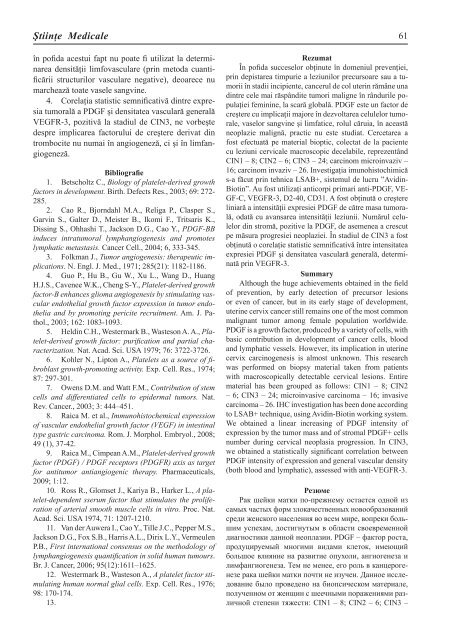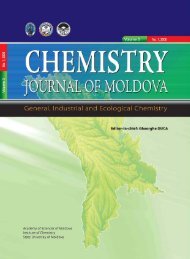stiinte med 1 2012.indd - Academia de ÅtiinÅ£e a Moldovei
stiinte med 1 2012.indd - Academia de ÅtiinÅ£e a Moldovei
stiinte med 1 2012.indd - Academia de ÅtiinÅ£e a Moldovei
Create successful ePaper yourself
Turn your PDF publications into a flip-book with our unique Google optimized e-Paper software.
Ştiinţe Medicale<br />
în pofida acestui fapt nu poate fi utilizat la <strong>de</strong>terminarea<br />
<strong>de</strong>nsităţii limfovasculare (prin metoda cuantificării<br />
structurilor vasculare negative), <strong>de</strong>oarece nu<br />
marchează toate vasele sangvine.<br />
4. Corelaţia statistic semnificativă dintre expresia<br />
tumorală a PDGF şi <strong>de</strong>nsitatea vasculară generală<br />
VEGFR-3, pozitivă la stadiul <strong>de</strong> CIN3, ne vorbeşte<br />
<strong>de</strong>spre implicarea factorului <strong>de</strong> creştere <strong>de</strong>rivat din<br />
trombocite nu numai în angiogeneză, ci şi în limfangiogeneză.<br />
Bibliografie<br />
1. Betscholtz C., Biology of platelet-<strong>de</strong>rived growth<br />
factors in <strong>de</strong>velopment. Birth. Defects Res., 2003; 69: 272-<br />
285.<br />
2. Cao R., Bjorndahl M.A., Religa P., Clasper S.,<br />
Garvin S., Galter D., Meister B., Ikomi F., Tritsaris K.,<br />
Dissing S., Ohhashi T., Jackson D.G., Cao Y., PDGF-BB<br />
induces intratumoral lymphangiogenesis and promotes<br />
lymphatic metastasis. Cancer Cell., 2004; 6, 333-345.<br />
3. Folkman J., Tumor angiogenesis: therapeutic implications.<br />
N. Engl. J. Med., 1971; 285(21): 1182-1186.<br />
4. Guo P., Hu B., Gu W., Xu L., Wang D., Huang<br />
H.J.S., Cavenee W.K., Cheng S-Y., Platelet-<strong>de</strong>rived growth<br />
factor-B enhances glioma angiogenesis by stimulating vascular<br />
endothelial growth factor expression in tumor endothelia<br />
and by promoting pericite recruitment. Am. J. Pathol.,<br />
2003; 162: 1083-1093.<br />
5. Heldin C.H., Westermark B., Wasteson A. A., Platelet-<strong>de</strong>rived<br />
growth factor: purifi cation and partial characterization.<br />
Nat. Acad. Sci. USA 1979; 76: 3722-3726.<br />
6. Kohler N., Lipton A., Platelets as a source of fi -<br />
broblast growth-promoting activity. Exp. Cell. Res., 1974;<br />
87: 297-301.<br />
7. Owens D.M. and Watt F.M., Contribution of stem<br />
cells and differentiated cells to epi<strong>de</strong>rmal tumors. Nat.<br />
Rev. Cancer., 2003; 3: 444–451.<br />
8. Raica M. et al., Immunohistochemical expression<br />
of vascular endothelial growth factor (VEGF) in intestinal<br />
type gastric carcinoma. Rom. J. Morphol. Embryol., 2008;<br />
49 (1), 37-42.<br />
9. Raica M., Cimpean A.M., Platelet-<strong>de</strong>rived growth<br />
factor (PDGF) / PDGF receptors (PDGFR) axis as target<br />
for antitumor antiangiogenic therapy. Pharmaceuticals,<br />
2009; 1:12.<br />
10. Ross R., Glomset J., Kariya B., Harker L., A platelet-<strong>de</strong>pen<strong>de</strong>nt<br />
sserum factor that stimulates the proliferation<br />
of arterial smooth muscle cells in vitro. Proc. Nat.<br />
Acad. Sci. USA 1974, 71: 1207-1210.<br />
11. Van <strong>de</strong>r Auwera I., Cao Y., Tille J.C., Pepper M.S.,<br />
Jackson D.G., Fox S.B., Harris A.L., Dirix L.Y., Vermeulen<br />
P.B., First international consensus on the methodology of<br />
lymphangiogenesis quantifi cation in solid human tumours.<br />
Br. J. Cancer, 2006; 95(12):1611–1625.<br />
12. Westermark B., Wasteson A., A platelet factor stimulating<br />
human normal glial cells. Exp. Cell. Res., 1976;<br />
98: 170-174.<br />
13.<br />
61<br />
Rezumat<br />
În pofida succeselor obţinute în domeniul prevenţiei,<br />
prin <strong>de</strong>pistarea timpurie a leziunilor precursoare sau a tumorii<br />
în stadii incipiente, cancerul <strong>de</strong> col uterin rămâne una<br />
dintre cele mai răspândite tumori maligne în rândurile populaţiei<br />
feminine, la scară globală. PDGF este un factor <strong>de</strong><br />
creştere cu implicaţii majore în <strong>de</strong>zvoltarea celulelor tumorale,<br />
vaselor sangvine şi limfatice, rolul căruia, în această<br />
neoplazie malignă, practic nu este studiat. Cercetarea a<br />
fost efectuată pe material bioptic, colectat <strong>de</strong> la paciente<br />
cu leziuni cervicale macroscopic <strong>de</strong>celabile, reprezentând<br />
CIN1 – 8; CIN2 – 6; CIN3 – 24; carcinom microinvaziv –<br />
16; carcinom invaziv – 26. Investigaţia imunohistochimică<br />
s-a făcut prin tehnica LSAB+, sistemul <strong>de</strong> lucru ”Avidin-<br />
Biotin”. Au fost utilizaţi anticorpi primari anti-PDGF, VE-<br />
GF-C, VEGFR-3, D2-40, CD31. A fost obţinută o creştere<br />
liniară a intensităţii expresiei PDGF <strong>de</strong> către masa tumorală,<br />
odată cu avansarea intensităţii leziunii. Numărul celulelor<br />
din stromă, pozitive la PDGF, <strong>de</strong> asemenea a crescut<br />
pe măsura progresiei neoplaziei. În stadiul <strong>de</strong> CIN3 a fost<br />
obţinută o corelaţie statistic semnificativă între intensitatea<br />
expresiei PDGF şi <strong>de</strong>nsitatea vasculară generală, <strong>de</strong>terminată<br />
prin VEGFR-3.<br />
Summary<br />
Although the huge achievements obtained in the field<br />
of prevention, by early <strong>de</strong>tection of precursor lesions<br />
or even of cancer, but in its early stage of <strong>de</strong>velopment,<br />
uterine cervix cancer still remains one of the most common<br />
malignant tumor among female population worldwi<strong>de</strong>.<br />
PDGF is a growth factor, produced by a variety of cells, with<br />
basic contribution in <strong>de</strong>velopment of cancer cells, blood<br />
and lymphatic vessels. However, its implication in uterine<br />
cervix carcinogenesis is almost unknown. This research<br />
was perfor<strong>med</strong> on biopsy material taken from patients<br />
with macroscopically <strong>de</strong>tectable cervical lesions. Entire<br />
material has been grouped as follows: CIN1 – 8; CIN2<br />
– 6; CIN3 – 24; microinvasive carcinoma – 16; invasive<br />
carcinoma – 26. IHC investigation has been done according<br />
to LSAB+ technique, using Avidin-Biotin working system.<br />
We obtained a linear increasing of PDGF intensity of<br />
expression by the tumor mass and of stromal PDGF+ cells<br />
number during cervical neoplasia progression. In CIN3,<br />
we obtained a statistically significant correlation between<br />
PDGF intensity of expression and general vascular <strong>de</strong>nsity<br />
(both blood and lymphatic), assessed with anti-VEGFR-3.<br />
Резюме<br />
Рак шейки матки по-прежнему остается одной из<br />
самых частых форм злокачественных новообразований<br />
среди женского населения во всем мире, вопреки большим<br />
успехам, достигнутым в области своевременной<br />
диагностики данной неоплазии. PDGF – фактор роста,<br />
продуцируемый многими видами клеток, имеющий<br />
большое влияние на развитие опухоли, ангиогенеза и<br />
лимфангиогенеза. Тем не менее, его роль в канцерогенезе<br />
рака шейки матки почти не изучен. Данное исследование<br />
было проведено на биопсическом материале,<br />
полученном от женщин с шеечными поражениями различной<br />
степени тяжести: СIN1 – 8; CIN2 – 6; CIN3 –

















